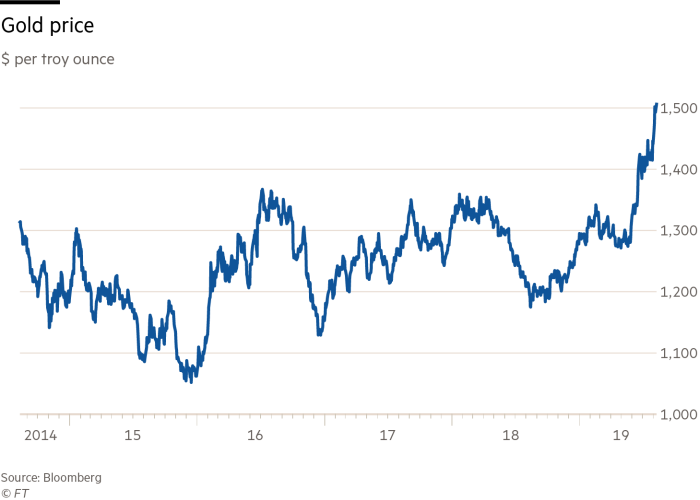Four ways to hold gold as a safe haven investment

Simply sign up to the Investments myFT Digest -- delivered directly to your inbox.
Gold caught investors’ attention again this week as experts predicted its price could soar to highs of $2,000 an ounce within the next two years.
In a research note, Citigroup analysts said slowing global growth and potential interest rate cuts in the US could drive the gold price up, as investors seek to reduce risk.
Soaring prices also prompted The Royal Mint to announce its intention to launch a gold-backed exchange traded commodity (ETC) in response to rising demand from investors. The new ETC will allow savers to invest in the yellow metal without having to buy physical gold.
“For thousands of years, gold has been recognised worldwide as the ultimate means of trading and storing wealth,” said Anne Jessopp, chief executive of the Royal Mint.
The price of gold has risen by 18 per cent this year, reaching more than $1,550 an ounce this month for the first time since April 2013.

Fears that trade tensions between the US and China could cause a global downturn, continuing unrest in the Middle East and continuing uncertainty around the UK’s Brexit negotiations have all given the precious metal a boost.
Although gold is a non-yielding asset, it is perceived as a safe harbour for investors amid gathering market storms said Vincent Ropers, portfolio manager of the TB Wise multi-asset growth fund. “It is a classic inflation hedge. Indeed, in times of economic uncertainty, gold is considered impervious to the actions of centralised institutions.”
Experts also see gold as a good diversifier and enduring store of value. This is because the price of gold tends to move in a different direction from other assets such as equities.
Robin McDonald, head of multi manager investments at Schroders, said: “We’re pretty bullish about gold on a 12-18 month view, believing that it has a decent chance of helping diversify a balanced portfolio in ways that bonds struggle to do with such low yields.”
He added: “In the event of a potential downturn we are optimistic that gold will perform strongly, particularly as the policy response will probably involve zero or negative rates, more money printing and fiscal expansion that will result in the market questioning expectations of long-term low inflation.”
Adrian Lowcock, head of personal investing at Willis Owen, said gold’s ability to act as a store of value was attractive. However, he warned that in the short term the gold price has become more susceptible to speculators and added: “The price is arguably more volatile as investors can more easily move in and out of the asset class.”
Mr Lowcock suggested investors should hold no more than 5 per cent of their portfolio in gold. “It is an asset class different from any other and acts as an excellent way to diversify your portfolio as well as an insurance policy to protect your wealth,” he said.
Having weighed up the risks, there are a number of ways for investors to hold gold:
1 Invest in exchange traded commodities (ETCs)
Exchange traded commodities track the spot price of gold and work in the same way as tracker funds, replicating the ups and downs of the gold price. They can be traded at any time when markets are open, and many can be held within Isas and Sipps. There is normally a broker commission to pay on their purchase and sales and an annual charge of about 0.5 per cent, but no stamp duty or initial charge.
Peter Sleep, senior investment manager at Seven Investment Management, is not a huge fan of gold in the current climate but said that for those who wish to invest in the precious metal, by far the easiest way is to buy a gold ETC. “We own a small amount of the Invesco Physical Gold ETC, which costs 0.24 per cent,” he said.
2 Buy physical gold
Investors can buy the real thing in the form of gold coins, which are widely available, or bullion bars, which are a bit harder to buy. However, investors need to consider the cost of security and storage, insurance and delivery charges. It is possible to buy and sell gold via online trading platforms such as bullionvault.com, which will match investments with physical gold bullion held in vaults.
3 Invest directly in gold shares
Those prepared to take on more risk could consider investing directly in shares in gold miners. However, performance tends to be volatile and profits will depend not only on the price of gold and the quantity produced, but also the cost of production.
Danny Cox, chartered financial planner at Hargreaves Lansdown, said two factors that set investing in gold miners apart from ETCs were the potential for gold price-beating returns, and dividends. “As you would expect, miners’ fortunes are closely linked to the gold price. And when gold prices are high, miners can be highly profitable, and can invest in new mines and return cash to shareholders. When gold prices are low, some miners will struggle,” he said.
4 Consider gold funds
Given the unpredictability of the sector, another option could be considering a more diversified fund of gold miners, such as BlackRock’s Gold & General fund or the JPM Natural Resources fund. Funds offer greater diversification as they invest in a portfolio of gold mining companies chosen by fund managers — meaning they also have ongoing charges, typically around 1 per cent.
Investors should also be aware that such funds do not solely invest in gold miners and tend to have exposure to other precious metals. Likewise, gold miners are unlikely to be solely involved in mining gold, and will produce other resources. So there is no guarantee that their share prices, or the price of fund units, will replicate gold price movements.

Comments